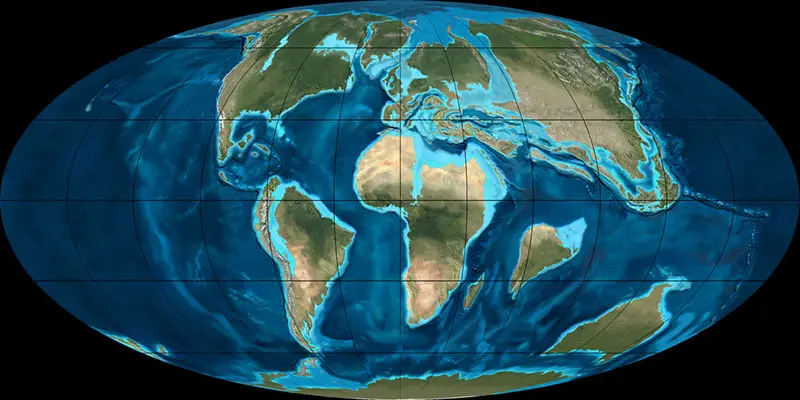†Pronothodectes (Plesiadapidae)
Pronothodectes ist eine Primatengattung innerhalb der Familie Plesiadapidae, deren 4 Mitglieder ab dem frühen Paläogen (Paläozän) im Danium lebten, das vor ungefähr 66 Millionen Jahren begann und bis vor 61,6 Millionen Jahren andauerte. Viele Überreste wurden in Vereinigte Staaten von Amerika (USA) gefunden.
Der älteste und primitivste bekannte Plesiadapide ist Pronothodectes aus der Familie Plesiadapidae (Klade Euprimateformes), der im Paläozän vor über 60 Millionen Jahren lebte.
Die Zahnformel lautet $frac {2.1.3.3} {2.1.2.2}$. Die dem Pronothodectes nachfolgenden Plesiadapidae verloren im Laufe der Evolution den zweiten unteren Schneidezahn und manchmal auch die Eckzähne sowie einen Prämolar, was ein auffälliges Diastema an der Vorderseite des Kiefers zur Folge hatte, etwa vergleichbar mit Nagetieren.
Pronothodectes jepi
Das Typusexemplar mit der Nummer PU 14782 ist ein linker Unterkiefer mit Alveoli für die Schneidezähne I1-2, den Eckzahn und den zweiten Prämolaren P2, sowie den Kronen der Prämolare P3-4 und Molare M1-3. Der Fund stammt aus dem Park County, Wyoming und ist zwischen 63,3 und 60,2 Millionen Jahre alt.
| Sammlung | Kommentar zum Fundort | Epoche, Alter | Geologie, Formation |
|---|---|---|---|
| Rock Springs Uplift (UW V-77012) | Fort Union | ||
| Museum | |||
| UW |
| Physiologie | |
|---|---|
| Gewicht: | ? |
| Schwestertaxa | |
Pronothodectes matthewi
Das Typusexemplar mit der Bezeichnung U.S.N.M. no. 9547 ist ein Teil eines rechten Oberkiefers mit Prämolaren und Molaren (P4-M2). Der Fund stammt aus der Fort Union Formation (Sweetgrass County, Montana) und ist zwischen 63,3 und 60,2 Millionen Jahre alt.
| Sammlung | Kommentar zum Fundort | Epoche, Alter | Geologie, Formation | Kommentar zur Sammlung |
|---|---|---|---|---|
| Medicine Rocks Site 1 | Fort Union | Medicine Rocks I | ||
| Kommentar z. Stratigraphie | Lithographie | Kommentar z. Taxonomie | ||
| "The Medicine Rocks Sandstone, a unit that was originally mapped as part of the Tongue River Member of the Fort Union Formation. More recent work, however, has shown that the Medicine Rocks Sandstone is bounded by unconformities and it has thus been designated as its own unit, now called the Ekalaka Member of the Fort Union Formation YPM PU 16781 is from “Locality 1,” which Sloan (1970) grouped with other localities into an assemblage named Medicine Rocks I. A tentative Torrejonian 3 age is typically given on the basis of the mammalian assemblage found at that site (e.g., Lofgren et al. 2004)" (Joyce et al. 2009) | "sandstone" (Estes 1976) | said to be To3 several other localities in this area are Tiffanian Site III and Mehling Site are "at essentially the same stratigraphic level": Krause 1987a possibly relevant: Pantolambda bathmodon Simons 1960: "probably occurs in the Medicine Rocks local fauna" Pantolambda cavirictum Simons 1960: "Medicine Rock local fauna" SEE Sloan 1970 |
Literatur
P. D. Gingerich 1976, Cranial Anatomy and Evolution of Early Tertiary Plesiadapidae (Mammalia, Primates). University of Michigan Papers on Paleontology. 15, p. 1 - 141K. D. Rose 1981, The Clarkforkian Land-Mammal Age and Mammalian Faunal Composition Across the Paleocene-Eocene Boundary. University of Michigan Papers on Paleontology. 26, p. 1 - 197
G. F. Winterfeld 1982, Mammalian paleontology of the Fort Union Formation (Paleocene), eastern Rock Springs Uplift, Sweetwater County, Wyoming. Contributions to Geology, University of Wyoming. 21:1, p. 73 - 112
J. E. Hartman 1986, Paleontology and biostratigraphy of lower part of Polecat Bench Formation, southern Bighorn Basin, Wyoming. Contributions to Geology, University of Wyoming. 24:1, p. 11 - 63
R. C. Fox 1990, Pronothodectes gaoi n. sp. from the Late Paleocene of Alberta, Canada, and the Early Evolution of the Plesiadapidae (Mammalia, Primates). Journal of Paleontology. 64:4, p. - 63
R. Secord 1998, Paleocene mammalian biostratigraphy of the Carbon Basin, southeastern Wyoming, and age constraints on local phases of tectonism. Rocky Mountain Geology. 33:1, p. 119 - 154, DOI: 10.2113/33.1.119
C. S. Scott, M. W. Webb, R. C. Fox 2006, Horolodectes sunae, an enigmatic mammal from the late Paleocene of Alberta, Canada. Journal of Paleontology. 80:5, p. 1009 - 1025, DOI: 10.2113/33.1.119
D. M. Boyer, C. S. Scott, R. C. Fox 2012, New craniodental material of Pronothodectes gaoi Fox (Mammalia, "Plesiadapiformes") and relationships among members of Plesiadapidae. American Journal of Physical Anthropology. 147:4, p. 511 - 550, DOI: 10.2113/33.1.119
C. S. Scott, D. N. Spivak, A. R. Sweet 2013, First mammals from the Paleocene Porcupine Hills Formation of southwestern Alberta, Canada. Canadian Journal of Earth Sciences. 50:4, p. 355 - 378, DOI: 10.2113/33.1.119
